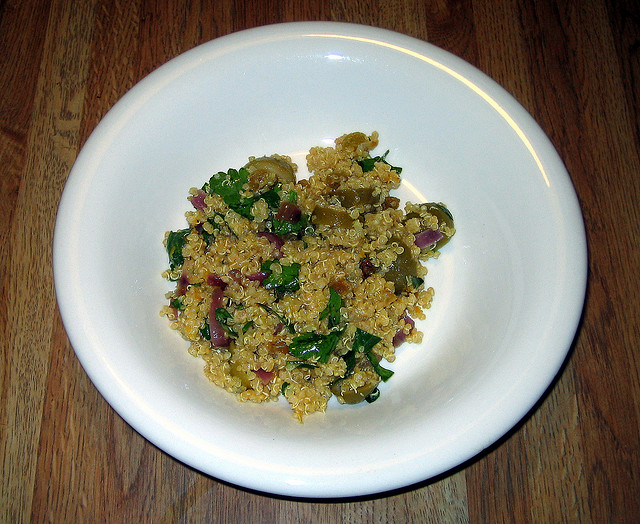
A quinoa salad, the latest sneeze among boutique eaters who are mostly oblivious to the consequences of their enthusiasm. (Photo by Karen and Brad Emerson/Flickr)
The epigraph for the book The Ugly American, an account of the destruction wrought by American good intentions in Southeast Asia, is a quote from Graham Greene (in which the word “dumb” means incapable of speech, not stupid): “Innocence is like a dumb leper who has lost his bell, wandering the world, meaning no harm.” A new incarnation of the syndrome, the Ugly American Consumer, wanders the world bestowing money on its natives, presuming that he is bestowing blessings. Case in point: quinoa.
(First let me stipulate that it is no more fair to attribute this ugliness exclusively to Americans than it was for the French and English to be let off the hook for their bloody-mindedness in Southeast Asia. But here, as elsewhere, America leads.)
Quinoa (which is pronounced keen-oh’-ah) has become as essential as Evian water and cultured yogurt to today’s boutique eaters, those who are educated enough to think they can manage their body’s metabolism (educated enough, that is, to be dangerous) and rich enough to ricochet from food fad to food fad. (The millions of people in the world who are being introduced to famine by today’s exploding food prices are not part of this story.) Quinoa has a wonderful backstory — it was revered and called the Mother of All Grains by the Incas, no less (who did not know it was not actually a grain, that it should properly be called the Mother of All Spinach). It has impressive credentials — it has been labelled a “superfood” by the United Nations, no less (who had no idea what the unintended consequences would be).
Quinoa deserves the accolades it has received during its 5,000 years of cultivation. It is a complete protein, which means it has all nine essential amino acids, plus another, lysine, which is essential for tissue growth and repair. The seeds are a good source of manganese, magnesium, iron, copper and phosphorous. It is a hardy plant, at home in the harsh environs of its native Andes Mountains. It has for five millennia been a worthy staple food for the people who live there.
Funny story. As the quinoa-gruel fad took hold around the world, and prices tripled in five years, its growers, the rural people of Bolivia and Peru, experienced a new kind of prosperity. The kind of prosperity that brought them more cash money than they had ever seen, but less than they now need to buy quinoa to eat. According to the New York Times, local consumption of quinoa has fallen by 34 per cent in five years.
This is not perceived as a tragedy by those affected — yet. With their newfound “wealth” they can now afford to be the consumers they have always wanted to be, just like their rich cousins to the north. The children, especially, have adapted enthusiastically to their new, and newly affordable, staples — white bread and Coca-Cola. Chronic malnutrition in children is rising dramatically in quinoa-growing regions.
It is one thing to bemoan the predations of industrial agriculture and industrial food processors. But boutique eaters who demand that nutritious goodies be brought to their tables from all corners of the earth, while everything their bodies truly need is being grown within a few miles of where they sit, are practicing a new and improved brand of colonialism. And they sometimes resemble dumb lepers, without bells.
The Graham Greene quote comes from The Quiet American, not The Ugly American (which was written by Eugene Burdick and William Lederer, not Greene). Yes I know the similar titles are confusing — all the more reason to make sure that you are referring to what you think you are.
I did not say that Graham Greene wrote The Ugly American, I said he wrote the quote that was used as the
epigraph for The Ugly American. I have never been confused by either the titles of the two books or the names of their authors. All the more reason to make sure you understand the sentence you set out to correct.
Great to see your interest in the impact of quinoa commercialization and globalization on quinoa farmers, but I would suggest you read the Andean Information Network memo on quinoa production and food security (http://ain-bolivia.org/2011/05/bolivian-quinoa-questions-production-and-food-security/) or my own post on the subject (http://andrewandamandaineurope.blogspot.com/2011/04/is-quinoa-commercialization-hurting.html) for a more nuanced view of the issue.
The impact of quinoa exports on Bolivian consumers isn’t nearly as significant as the Times article makes it out to be, as you can see in the two linked articles. The negative impacts of quinoa commercialization are more apparent in the environmental effects of intensifying production practices in some areas on a relatively fragile agro-ecosystem (http://www.ruralter.org/index.php?option=com_flexicontent&view=items&cid=17&id=89:cultivo-sostenible-de-la-quinua-en-bolivia-practicas-individuales-y-reglas-colectivas-praxis&Itemid=100002). I completely agree with your point here – that consumers should be aware the impacts of consumption on farmers and consumers – but simply want to straighten out some facts.